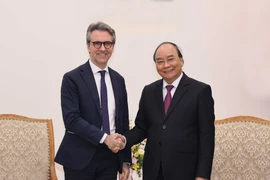 The EVFTA is expected to help Vietnam’s textile and garment industry to increase its shipments to the EU by some 67 percent by 2025 (Photo: VNA).
The EVFTA is expected to help Vietnam’s textile and garment industry to increase its shipments to the EU by some 67 percent by 2025 (Photo: VNA).Hanoi (VNA) – The Ministry of Industry and Trade (MoIT) and theMinistry of Trade, Industry and Energy of the Republic of Korea (RoK) recentlysigned an exchange letter on the implementation of the cumulation of origin of textilebetween the two nations under the EU-Vietnam Free Trade Agreement.
The letter was inked in the framework of the 10th meeting of the Vietnam-RoK Joint Committee onEnergy, Industry and Trade Cooperation and the4th meeting of the joint committee on the implementation of the Vietnam-RoKFree Trade Agreement (VKFTA), the MoIT’s Asia-Africa Market Departmentsaid, adding the document is significant to help Vietnamese firms easily accesshigh-quality textile materials from the RoK for production for export to theEU.
The EU needs to import more than 250 billion USD worth of garment and textileproducts each year; however, Vietnam accounted for only 2 percent of share inthis potential market, according to the MoIT.
The EVFTA, effective from August 2020, is expected to helpVietnam’s textile and garment industry to increase its shipments to the EU bysome 67 percent by 2025 as compared to the scenario without the pact.
However, according to the commitments of the EVFTA, besides meeting strictquality criteria, to enjoy preferential tariffs local businesses must implementstrict origin requirements. Specifically, exports to the EU must use fabricproduced in Vietnam or the EU. The agreement also allows firms to use fabricfrom countries which have FTAs with both Vietnam and the EU.
This issue is still a weakness for the local textile and garment industrybecause most raw materials are imported from countries that have not signedFTAs with the EU.
In this context, Vietnam negotiated with the EU countries on cumulative rulesof origin, allowing Vietnamese exporters to use fabric made by a third-partycountry that has an FTA with the EU like the RoK.
Before the EVFTA took effect, the MoIT conducted a negotiation with the KoreanMinistry of Trade, Industry and Energy to carry out the cumulative rules underthe EVFTA./.




























